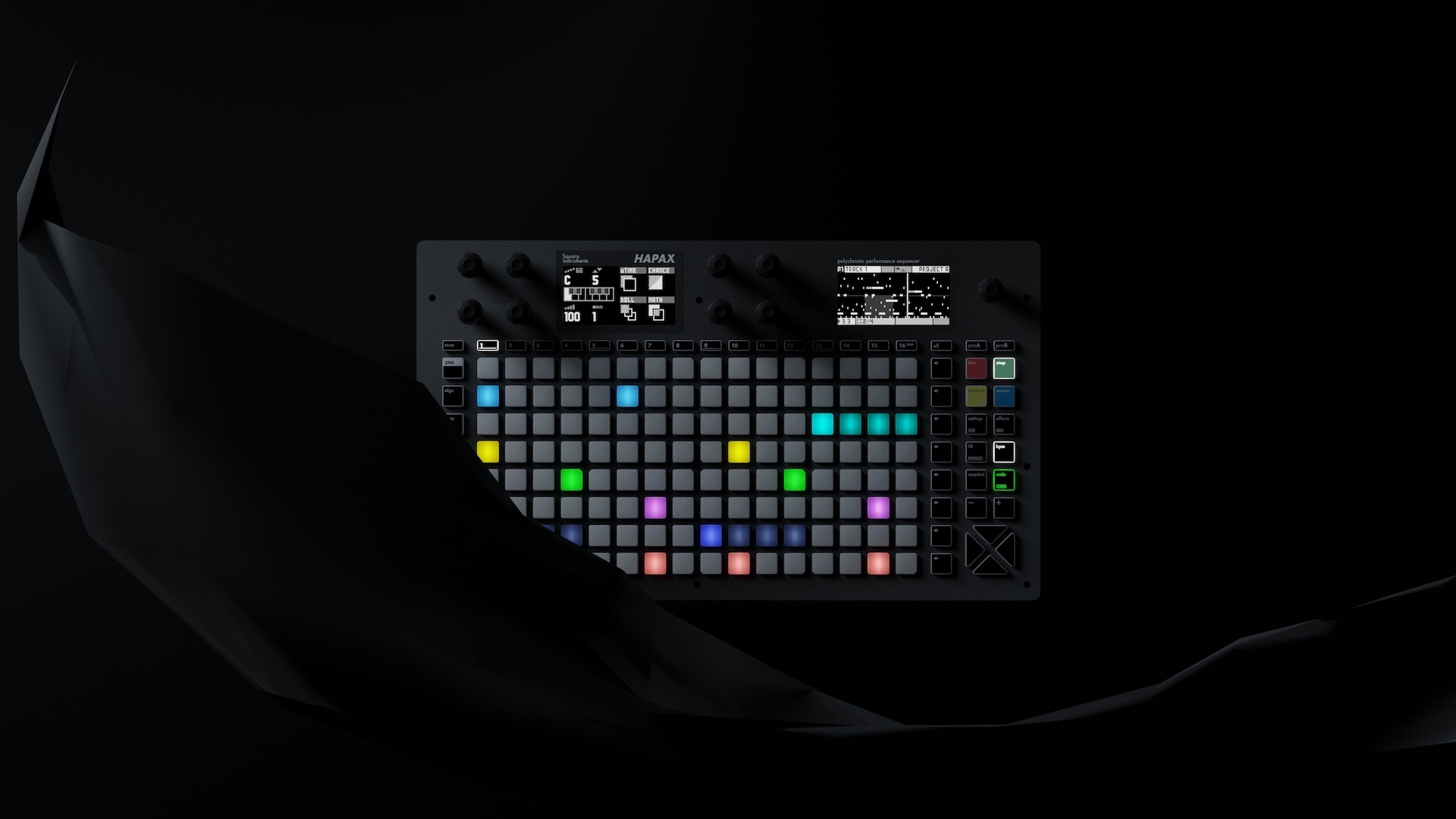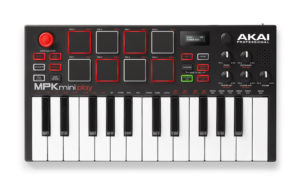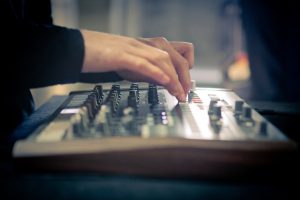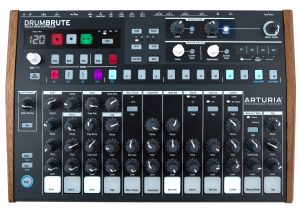

Squarp Instruments introduces Hapax high-end professional standalone sequencer as authentic setup centrepiece
PARIS, FRANCE: having originally designed and released Pyramid almost a decade ago as a compact, standalone 64-track hardware sequencer packed with creative tools that its music-making creators could not commercially find available elsewhere, subsequently applying that same thinking to their Hermod followup by bringing the power of MIDI to the ever- widening Eurorack modular world while inheriting some creative elements from its Pyramid precursor, Squarp Instruments is proud to introduce Hapax — duly designed from the ground up with dual-ARM processing architecture upping the computational power ante as a high-end professional standalone sequencer in a rugged, minimalist housing that deconstructs everything that the avant-garde machines-creating company already knew about sequencing to offer everything needed to compose songs in the studio and perform them onstage as an authentic centrepiece of any setup, sequencing and synchronising vintage to modern synths and modular systems, and even DAWs (Digital Audio Workstations), while maximising creativity with carefully crafted tools as the first hardware sequencer that fully supports MPE (MIDI Polyphonic Expression) — as of March 4…
Billed by its creators as a polychronic performance sequencer since it can clearly do many things at once, Hapax’s dual-processor architecture allows it to record and transform tremendous amounts of data in next to no time — and all without breaking into a sweat. As an around the clock performer, it can handle two separate and independent projects — each with 16 tracks and eight patterns per track — that can be played simultaneously, so users can compose or load another project while the first one is already playing, enabling endless sets and seamless transitions. The fact that Hapax is also the first hardware sequencer that fully supports MPE speaks volumes about Squarp Instruments’ intentions; it is perfectly possible to record the finest gestures, slides, and articulations of anything played, after all — and all without compromising quality.
Quality also shines forth for all to see and feel when it comes to the construction of the Hapax housing, manufactured from 2 mm machined aluminum, with a unibody ABS (Acrylonitrile Butadiene Styrene) back panel. Put it this way: with connections for multiple midi in (DIN and TRS), midi out (3x DIN and TRS), cv in (2x -5V to +5V/16-bit), cv out (4x -5V to +5V/16-bit), gate out (4x +5V), switch (stereo pedal footswitch), USB Host (for linking to a MIDI USB controller), and USB Device (for linking to a DAW-hosting computer and associated virtual instruments), it quickly becomes apparent just how well thought through that back panel actually is in terms of conceivably communicating with everything that the music technology world might make available at this moment in time — hence Hapax ably acting as an authentic centerpiece of any setup, sequencing and synchronizing vintage to modern synths and modular systems, and even DAWs.
Digging deeper, Hapax’s adaptive workflow — with the top panel proffering hands-on access to no fewer than 128 RGB (Red Green Blue) matrix pads, 52 click pads, nine sturdy clickable encoders, and two OLED (Organic Light-Emitting Diode) greyscale displays — is designed around four main modes: live uses those 128 pads as an isomorphic keyboard or chord generator, giving rise to harmonic capabilities aimed at anyone — regardless of their theoretical knowledge — as a synaesthetic sensory blend of hearing, vision, and touch, thanks to its colorful interface; step uses them to add or fine-tune notes (or drum events) with surgical precision; autom uses them to create MIDI (or effects) automation; and pattern enables performing in sync by using the 128 pads to set the playing pattern of each track — create sections (or groups of patterns) and chain sections to build a song. Making music might involve using a polyphonic or MPE track to take advantage of the advanced step sequencer and quickly lay down notes or edit live recordings when writing melodies, or control up to eight different instruments with a single track when creating beats using the drum sequencer that is tailored to ease rhythm writing and jamming, for instance.
It is also possible to effectively bring those connected synths to life since Hapax embeds multiple real-time, polyphonic, non-destructive MIDI effects, as well as project-wide assignable LFOs (Low Frequency Oscillators). On top of that, each parameter of those effects can be automated in the dedicated mode, and processed in the mod matrix, which provides even more ways of routing and modulating.
Hapax has so much more to offer discerning devotees of hardware sequencers, with powerful tools for offline note transformation and generation always at hand — harmonically inverting a musical motif, generating a controlled random counter-melody, slowly ramping up the velocities, emphasizing every fifth eighth note… almost anything is possible! Hitting Hapax’s red button enables recording using the encoders and matrix pads, external MIDI instruments (including MPE controllers), or any incoming analogue signal at a high resolution of 192 PPQN (Pulses Per Quarter Note). Needless to say, looper-style recording, countdown and metronome options, and punch-in mode means that there are options to suit any workflow, while each track has an elasticity value that changes its playback speed, expressed as a percentage of BPM (Beats Per Minute) — quickly double or halve the speed of a track, for example, or create subtly shifted tracks that slowly drift out of phase with each other.
Of course, hardware usage should not — in a perfect world — curb creative flow. For this reason, Hapax has a dedicated undo REDO button with extensive history to enable its users to go back in time as deemed necessary; thankfully, the button-activated snapshot function allows users to save the state of a pattern for instant recall with a single press; and dedicated copy, paste, and delete buttons help Hapax on its way towards offering a complete toolbox for promptly editing tracks.
Music-making should always remain an enjoyable experience, though, which is why Squarp Instruments favored dedicated buttons over key combinations when realizing a clear-cut interface and simple architecture for Hapax. Having striven to minimize the importance of screens when performing live, however, the dual greyscale displays implemented in Hapax help with keeping track of things in a studio context.
Clearly, then, deconstructing everything that they already knew about sequencing to offer everything needed to compose songs in the studio and perform them onstage as an authentic centerpiece of any setup has paid off for Squarp Instruments, with the Hapax high-end professional standalone sequencer surely set to make its mark in the music technology world while literally living up to its polychronic performance sequencer billing when expected for delivery in June 2022.
Hapax is available on backorder for expected delivery in June 2022 — priced at €864.00 EUR (plus VAT for individual customers in the European Union)/$979.00 USD — directly from Squarp Instruments’ online Store here: https://store.squarp.net
For more in-depth information, please visit the dedicated Hapax webpage here: https://squarp.net/hapax
Watch Squarp Instruments’ illuminating introduction to Hapax here: https://youtu.be/IdkW51BxfOA











